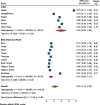Minimum acceptable diet and associated factors among children aged 6-23 months in Ethiopia: a systematic review and meta-analysis
- PMID: 38424574
- PMCID: PMC10903031
- DOI: 10.1186/s12887-024-04635-z
Minimum acceptable diet and associated factors among children aged 6-23 months in Ethiopia: a systematic review and meta-analysis
Abstract
Background: To ensure a child's full growth, health, and development during infancy and the early years, adequate nutrition is crucial. A crucial window of opportunity for ensuring children's proper growth and development through adequate eating exists during the first two years of life. According to the evidence of the efficacy of interventions, achieving universal coverage of optimal breastfeeding could prevent 13% of deaths in children under the age of 5 worldwide, and using complementary feeding methods appropriately would lead to an additional 6% decrease in under-five mortality.
Methods: From several electronic databases, all published, unpublished, and gray literature was extracted and exported into EndNote version X20. For further analysis of the review, the retrieved data from the excel sheet were imported into the statistical software program Stata version. Metanalysis was used to determine the prevalence of MAD, and a random effects model was used to estimate the pooled prevalence of MAD. The DerSimonian-Laird Random effects model (REM) was used to combine the determinant factors from all qualifying papers for the meta-analysis, and the heterogeneity was independently assessed using a χ2 test, Q statistics, and matching I2 statistics. To retrieve the extent of publication bias, funnel plots were scattered and tested for asymmetry and, additionally, Egger's test was computed with the user-written "meta bias" command in Stata (version 11) software. To end, sensitivity analyses with trim and fill were performed.
Results: The pooled estimate of the overall prevalence of minimum acceptable diet in 16 studies in Ethiopia was 22% with (95% CI: 16, 28%) with a random effect model. However, eight papers were filled during trim and fill in order to counteract the small study effect. The overall filled pooled estimate was 7.9% with (95%CI: 11, 14.8%). Maternal education (primary and secondary) is 1.714 (95% CI 1.244,2.363) and 2.150(95% CI: 1.449,3.190), respectively, Ages of children with range of 12-17 months (2.158 (95% CI 1. 9,3.006) and 18-23 months 2.948(95% CI: 1.675,5.190)), Nutrition information ((1.883 (95% CI 1.169,3.032)) media exposure (1.778(95% CI: 1.396,2.265), and maternal knowledge (2.449 (95% CI 1.232, 5.027) were significantly associated with MAD.
Conclusion: The pooled estimate of the overall prevalence of minimum acceptable diet in 16 studies in Ethiopia were low. Maternal education (primary and secondary), ages of child with range of 12-17 month and 18-23 months, mothers having nutrition information, mothers who have media exposure,and mothers having good knowledge were significantly associated with Minimum acceptable diet. The government, NGO, and other stakeholders should focus on improving Minimum acceptable diet among 6 to 23 months of children through promoting with mass media, focuses on nutrition council during critical contact point in health facility, and doing capacity building for the mothers/caregivers.
Keywords: Dietary diversity; Ethiopia.; Meal frequency; Minimum acceptable diet; Systematic review.
© 2024. The Author(s).
Conflict of interest statement
The authors declare no competing interests.
Figures















Similar articles
-
Minimum acceptable diet and associated factors among 6-23 months old children enrolled in outpatient therapeutic program in the Tulla district, Sidama region, Ethiopia: a community-based cross-sectional study.J Health Popul Nutr. 2024 Jul 8;43(1):106. doi: 10.1186/s41043-024-00581-9. J Health Popul Nutr. 2024. PMID: 38978134 Free PMC article.
-
Dietary Diversity and Associated Factors among Children 6-23 Months Old in Ethiopia: Systematic Review and Meta-Analysis.Discov Med. 2024 Jul;36(186):1527-1543. doi: 10.24976/Discov.Med.202436186.141. Discov Med. 2024. PMID: 39054722
-
Minimum acceptable dietary intake among children aged 6-23 months in Ethiopia: A systematic review and meta-analysis.PLoS One. 2023 Jun 29;18(6):e0287247. doi: 10.1371/journal.pone.0287247. eCollection 2023. PLoS One. 2023. PMID: 37384754 Free PMC article.
-
Magnitude of postpartum hemorrhage and its associated factors in Ethiopia: a systematic review and meta-analysis.Reprod Health. 2022 Mar 9;19(1):63. doi: 10.1186/s12978-022-01360-7. Reprod Health. 2022. PMID: 35264188 Free PMC article.
-
Dietary diversity feeding practice and its associated factors among children age 6-23 months in Ethiopia from 2011 up to 2018: a systematic review and meta-analysis.Ital J Pediatr. 2018 Sep 17;44(1):109. doi: 10.1186/s13052-018-0567-9. Ital J Pediatr. 2018. PMID: 30223854 Free PMC article.
Cited by
-
Effect of single-parent versus dual-parent households on dietary intake and growth among under-five children in Rwanda: an analysis using directed acyclic graph.BMC Nutr. 2025 Jul 4;11(1):128. doi: 10.1186/s40795-025-01084-4. BMC Nutr. 2025. PMID: 40616166 Free PMC article.
-
Minimum acceptable diet and contributing factors among children aged 6-23 months in Afghanistan: insights from the 2022-2023 Multiple Indicator Cluster Survey.BMC Nutr. 2025 Jan 14;11(1):10. doi: 10.1186/s40795-025-00996-5. BMC Nutr. 2025. PMID: 39810266 Free PMC article.
-
Minimum acceptable diet and associated factors among 6-23 months old children enrolled in outpatient therapeutic program in the Tulla district, Sidama region, Ethiopia: a community-based cross-sectional study.J Health Popul Nutr. 2024 Jul 8;43(1):106. doi: 10.1186/s41043-024-00581-9. J Health Popul Nutr. 2024. PMID: 38978134 Free PMC article.
-
Micronutrient intake inadequacies in Northwest Ethiopian children aged 6-23 months.Sci Rep. 2024 Sep 5;14(1):20732. doi: 10.1038/s41598-024-68381-z. Sci Rep. 2024. PMID: 39237525 Free PMC article.
References
-
- World Health Organization. Global strategy for infant and young child feeding. World Health Organization; 2003.
-
- Organization, W.H., Infant and young child feeding: model chapter for textbooks for medical students and allied health professionals. 2009: World Health Organization. - PubMed
-
- Jones G, et al. How many child deaths can we prevent this year? Lancet. 2003;362(9377):65–71. - PubMed
Publication types
MeSH terms
LinkOut - more resources
Full Text Sources

